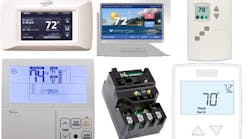Don’t give up the wall.
After hearing comments from controls wholesalers at the recent Heating, Air-conditioning & Refrigeration Distributors International (HARDI) convention, I’m concerned about utilities, among others, stealing the wall from HVAC contractors. What do I mean? You walk into a customer’s house and there’s an alien thermostat on the wall. Where did that come from, you ask? Oh, the utility gave that to us, is the reply. Worse yet, it’s a single-stage smart thermostat on the multi-stage system you had installed.
What if a utility uses an internet-connected thermostat to control equipment remotely? What if they try this in a commercial building?
Here’s a not-so-inconceivable scenario: what if a utility uses an internet-connected thermostat to control equipment remotely? What if they try this in a commercial building? Manufacturers and wholesalers are concerned because if something gets busted, the utility isn’t the one who gets blamed. The utility would be doing this in their best interest, not in the interest of either the equipment or occupant comfort.
Contractors have to be the ones leading the pushback on this. Don’t assume that you’re safe because you have a relationship — or even a service agreement — with a customer.
I’m not going to bash utilities because they’re trying to make a buck just like everyone else, but here’s what they’re up to. Utilities, which used to get paid no matter what, are trying to figure out ways to get paid for activities other than selling electricity. They haveHVAC contractors are letting this happen to them. You know why 70 percent of connected or smart thermostats are sold online or in big-box stores? Because homeowners want them and you aren’t selling them. Don’t fear the router. Homeowners want this so somebody is going to give it to them.
During the HARDI session, attendees were shown Honeywell research on smart controls in 2018. Connectivity and data diagnostics will be the norm and consumers will control nearly half of thermostat choice. Speaking of Honeywell, they’re a good ally for contractors seeking information on connected, communicating, smart homes.
By the way, I’ve heard that Honeywell Connected Home, as part of its expanding partnerships, pairings, and API integrations, kicked offHoneywell planned on introducing the IFTTT Connected Thermostat Channel at the Consumer Electronics Show although it will also be shown at AHR Expo, where I’m hoping to learn a lot more about it.
Don’t fear the router. This isn’t all that hard — that’s why so many homeowners are buying online and doing it themselves. The smart home networks that are on the market today aren’t overly sophisticated.
Don’t ever give up the wall.












